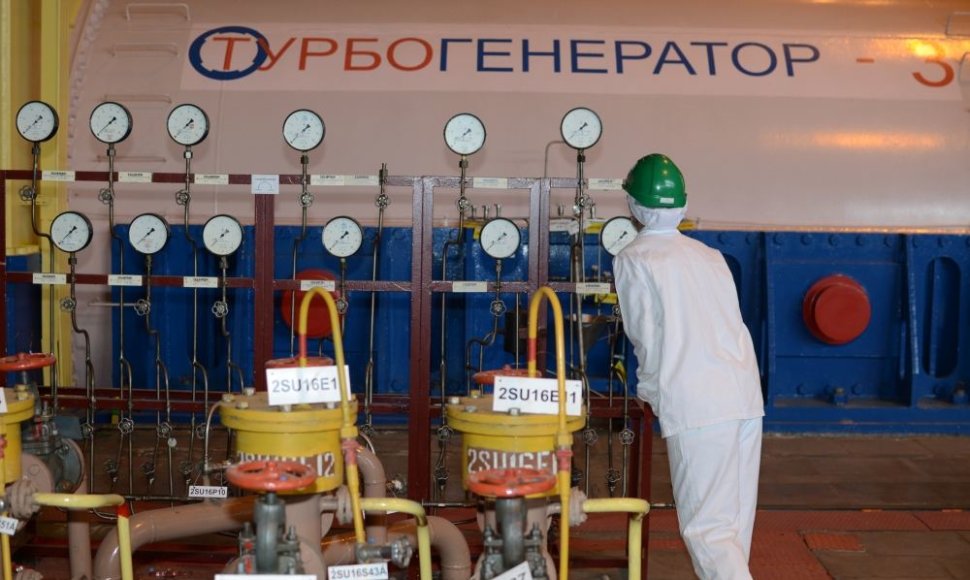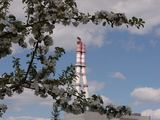 |
| V.Voskoboinikovo nuotr. /Nuclear waste is still kept within the plant's territory. |
“This year, we are planning to take 500 used uranium rods out of the second reactor. But there is no place to keep them,” a tour guide, Ina Daukšienė, tells our group while we head towards changing rooms.
Solid and liquid radioactive waste is being kept right here – within the territory of the plant. Not only spent nuclear fuel, which is deadly toxic, but everything that has ever “tasted” radiation – used gloves, for instance. Some waste needs to be kept safe for 30 years, other things last 300 years before they are safe, while spent fuel will have to be stored in special facilities for as long as human race lives on Earth.
It is a vast, radiation-breathing zone. It is hard to imagine how much further it would expand, if a site that was leveled for reactor 3 back in the Soviet times were used for another monstrous project, Visaginas Nuclear Power Plant (VNP).
Three changes of shoes in two metres
Theatre begins with a cloakroom, as the saying goes, and so does a nuclear plant. We are led into a tiny room where we are stripped to underwear. We are instructed to put on white cotton shirts, tuck them into baggy trousers, put on socks, shoes that are much too big – we must cover every inch of our bodies.
The next stop is several steps away. We see more footwear lined up along a line drawn on the floor, rubber slippers.
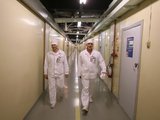 |
| Irmanto Gelūno/15min.lt nuotr./Long corridors |
“When you are changing shoes, be sure not to step on the floor bare-footed,” the guide warns us.
We take a few more steps and again – a new set of shoes with thick rubber soles. More clothes, too: thick cotton shirt, long trousers, ear-covering hat. I put a helmet on and the 20-minute dressing ceremony is over.
“Leave everything in the cloakroom – mobile phones, wallets, other things,” the guide instructs us insistently. “During the tour, walk only where you are permitted and don't touch anything.” Our group is accompanied by her and a Physic Safety Department specialist, carrying a radiometer in his pocket. As soon as it spots a rise in radiation levels, the tour is over.
Climbing the “pyatachyok”
We take a glass corridor to the 1st energy block. It was shut down on 31 December 2004 and now contains no nuclear fuel. However, we are not allowed to enter the block right away – “daily maintenance” works are underway at the moment, the guide explains, and outsiders are not welcome.
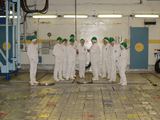 |
| V.Voskoboinikovo nuotr. /The reactor room |
We turn to a narrow half-a-kilometre-long corridor leading towards the 2nd energy block that was stopped on 31 December 2009 and still contains some nuclear fuel. Nothing too awe-inspiring yet – pipes running below the ceiling, blue-painted walls, a myriad of locked doors, and lines painted on the floor. The guide dims the room and the lines light up. “If power got cut off, one would have to run fast. And stick to the directions indicated by these lines,” she explains.
One door in this corridor is special. It hides the reason why INP was shut down – a Soviet-made water-graphite nuclear power reactor RBMK-1500. It is still alive and “breathing.” The power plant staff refers to it as the “pyatachyok.” “Why? Because it is round, reminds of a pig's snout or a five-kopeyk coin,” the guide smiles and encourages everyone to step on the reactor.
My legs slightly tremble as I step on the “pyatachyok.” Jokes about metal taste in one's mouth and glowing halos suddenly cease being funny. We move very carefully, as if walking on thin ice.
Bubbling teapot
“Reactor is like a teapot that is always on fire,” Ina, the guide, attempts at a simple explanation for a complex technology. “Underneath your feet are layers of sand, concrete, steel, graphite, water, etc. Also, control rods that
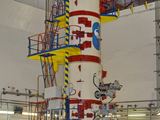 |
| V.Voskoboinikovo nuotr. /fuel transshipment machine |
absorb surplus neutrons and 1661 fuel rods that are 11 metres length. Each contains 110 kilograms of enriched uranium that lasts for about five years. Only then is the rod taken out. Technic water circulates in the reactor. Nuclear fuel heats the water, turning it into steam that travels to turbogenerators. Waters of lake Drūkšiai, used for cooling, got warmer by 3 degrees. That changed the lake's fauna and flora. But now, everything is slowly returning to normal.”
The guide points towards a piece of equipment that is a pride of the power plant staff – fuel transshipment machine. Just a pipe with a crane – the symbol of Visaginas – painted in bright colours.
“This “pipe” is special because it can take out and put in a heat-emitting rod without stopping the reactor. But it doesn't make any difference now... Do not assume that when the rod is being taken out, someone is in the room,” the guide point towards a small window with thick glass. “The process is operated from there, since spent nuclear fuel is deadly dangerous.”
Fatal number – 100
On the other side of the reactor room, there is a water canal leading to pools behind the wall. This is where spent uranium goes and soaks for five years. Only then can the rods be sealed into 3-metre-thick ferroconcrete containers and taken to temporary storage site. These containers are not, however, eternal – they keep the fuel safely sealed for 50 years.
We listen to the entire 30-minute lecture still standing on the “pyatachyok” and then rush to check how much radiation we've absorbed. We press our palms against a special machine. All clean – the screen shows zeros to almost everyone. But when we check our shoes, the figures are much more varied: 0, 7, 10, 16, 18, 28. The biggest figure that flashes on the screen is 42. The Physic Safety specialist reassures us that only figures over 100 would indicate danger to health.
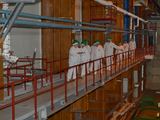 |
| V.Voskoboinikovo nuotr. /The machine room with 190 km of piping |
Our next stop on the tour – the Machine room. It houses four turbines with 800 MW generators. Each is 40 metres in length, 8.7 metres width and 5.2 metres height. These numbers say little until you stand next to a turbine and feel dwarfed to an ant.
The room is longer than you could see. Even turning your head doesn't help to see its end. It is said to contain 190 kilometres of piping.
And it is uncannily silent. Occasional sound of hammering can be heard coming from somewhere afar. “And only recently, the working turbines made so much noise one could hardly hear each other speak,” the guide recalls.
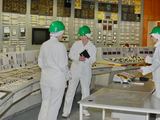 |
| V.Voskoboinikovo nuotr. /Control panel |
We suddenly realize that during our hour-long tour, we have only met a few workers. “Back in the day, there were 5 thousand workers and now – only 2,130 remain. They work in three shifts. Whether the plant is on or off, the view is much the same – no sight of people. Except in the morning when everyone goes to work and in the afternoon when all head for the canteen,” our guide explains. She then invites us to the last point in our tour – the “brain of the plant” as she calls it.
Soviet look
“The plant's brain” is a bow-shaped control panel with multitude of buttons and screens. The power plant contains two of those. Outside visitors can see the “brain” of block 1 which is already emptied of nuclear fuel. There are, however, a few lights still flashing on the panel – they indicate the operation of systems for fire safety, heating, lighting, drainage, ventilation. The panel looks nothing like modern state-of-the-art equipment – it smells of Soviet times. Chairs, too, are old and well-worn. The only thing that looks somewhat newer is an exercise machine attached to a wall.
“5-7 people plus a shift director, the most important person in the power plant, would always work here,” the guide tells us. “People already high up their career ladder used to work here, our best specialists. And now, there is only one man overlooking the panel. We still call him director.”
“Are you kidding, I'm just a simple security guard,” the man who has just been called director modestly lowers his eyes.
Before leaving, the guide shows us one more device – a seismology station behind the panel that constantly monitors earth surface tremors.
No easy way out
We head back through the same corridors towards changing rooms. Used clothes go straight to a waste bag, while we rush to scrub our hands with soap. But leaving the nuclear power plant is not that easy. “You will now talk to an English-speaking lady,” our guide smiles mysteriously.
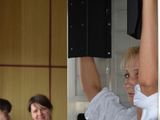 |
| V.Voskoboinikovo nuotr. /Measuring radiation levels |
One at a time, we pass through a special gate measuring radiation levels. “Turn front, raise your hands,” the device issues commands, in English, while slowly counting to ten. Next – turn back. Counting again. Finally, the verdict: “Clean.”
There is a sign with bulletpoints instructing what to do in case the machine voice says one is polluted. Step one: “Go to showers.” Second: “If after showering the situation does not change, call the shift director immediately.” There is no step three.
A note off the point: It might be a mere coincidence, but I have never seen houseplants blossom so lushly as those in the power plant's administration and canteen buildings – situated apart from the energy blocks.
A nuclear town
Residents in the town of Visaginas are among the most ardent supporters of plans to build a new nuclear plant there. However, after talking to some of them, one gets a feeling that very few of them actually believe that it is going to happen.
“You know, it's like faith in God – you either believe it or not. And what actually goes on up in heaven – no one really knows,” Sergei, a passer-by on the street, says. His story sounds a little ironic – his father came from the depths of Russia to build Ignalina Plant and Sergei is now taking it apart.
“We are deconstructing it until all that's left is a green lawn with brown spots – containers and burial site for nuclear waste. That is, of course, if these get built at all. So much money has been put into it already,” the middle-aged man says. “My colleagues and I often wonder: Wouldn't it have been better to gum up our plant instead of cutting it into pieces, like now.”
Visaginians claim they have not met any Japanese in their town yet, but they are well aware of the plans involving Hitachi. “Neither our schools, nor kindergartens or houses seem acceptable to them. They'll be building their own. Perhaps even fencing from us. We will be living like American Indians in a reservation,” Yelena fusses on her way to a new supermarket.
Visaginas has many supermarkets – people working at Ignalina Nuclear Power Plant still make decent money. Not as generous, though, as what they used to get after the Chernobyl accident. After the explosion in the Ukrainian plant, there was such a hike in pay that Ignalina Plant workers had to drag their money home in bags.
As rich as that made them, all Visaginas residents live in blocks of flats. All 26 thousand of them. There is only one private house in town, but it stands empty as there are no buyers to pay a million litas for it.
The town of Visaginas was built in 1975 and there are no two identical courtyards, except that all have newly-built children playgrounds and pine trees lining up the blocks. Streets are wide and do not have a single pothole. For recreation, Visaginians go to a sandy beach on a lake nearby. Nor do they hesitate to swim in lake Drūkšiai that used to cool nuclear reactors. They especially like the shore across the lake from the plant. They say it gives them a splendid view of their “breadwinner.”
The settlement around the nuclear power plant was built following a streetplan called “Butterfly.” Looking at Visaginas from bird's view, it does indeed look butterfly-shaped. It is, however, missing one wing – this wing should have appeared along with the third block. But after the Chernobyl explosions, the plans changed.

